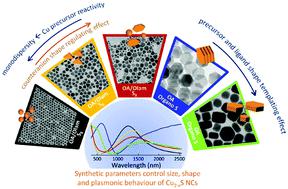当前位置:
X-MOL 学术
›
Mater. Chem. Front.
›
论文详情
Our official English website, www.x-mol.net, welcomes your feedback! (Note: you will need to create a separate account there.)
Cu2−xS nanocrystal synthesis: a chemical toolbox for controlling nanocrystal geometry, phase and plasmonic behavior
Materials Chemistry Frontiers ( IF 7 ) Pub Date : 2020-10-23 , DOI: 10.1039/d0qm00596g Mariangela Giancaspro 1, 2, 3, 4, 5 , Teresa Sibillano 3, 4, 6 , Francesca Panzarea 1, 2, 3, 4 , Cinzia Giannini 3, 4, 6 , Silvia Schmitzer 1, 2, 3, 4 , Fabio Vischio 1, 2, 3, 4, 7 , Nicoletta Depalo 3, 4, 7, 8 , Angela Agostiano 1, 2, 3, 4, 7 , M. Lucia Curri 1, 2, 3, 4, 5 , Marinella Striccoli 3, 4, 7, 8 , Elisabetta Fanizza 1, 2, 3, 4, 7
Materials Chemistry Frontiers ( IF 7 ) Pub Date : 2020-10-23 , DOI: 10.1039/d0qm00596g Mariangela Giancaspro 1, 2, 3, 4, 5 , Teresa Sibillano 3, 4, 6 , Francesca Panzarea 1, 2, 3, 4 , Cinzia Giannini 3, 4, 6 , Silvia Schmitzer 1, 2, 3, 4 , Fabio Vischio 1, 2, 3, 4, 7 , Nicoletta Depalo 3, 4, 7, 8 , Angela Agostiano 1, 2, 3, 4, 7 , M. Lucia Curri 1, 2, 3, 4, 5 , Marinella Striccoli 3, 4, 7, 8 , Elisabetta Fanizza 1, 2, 3, 4, 7
Affiliation

|
Cu2−xS nanocrystals (NCs) have been recently exploited in several fields, ranging from energy conversion to biomedical applications, due to their intriguing geometry and phase-dependent semiconductor and near-infrared plasmonic properties. Although advances have been made in their synthesis by hot-injection at the present stage of research, the unexpected sizes and shapes of the Cu2−xS NCs and broad polydispersity still represent critical issues that must be avoided, as they are responsible for the unpredictable optical response and undesirable broadening of the spectroscopic feature. This study intends to explore the influence that the reactants used in the Cu2−xS NC synthesis have in the modulation of size, shape and phase. Furthermore, we aim to provide an effective toolbox for a judicious choice of synthetic conditions towards the production of monodispersed and uniform NCs. The way how, the precursor nature, tied up with the composition of amphiphilic molecules, controls the final NC geometry (e.g., size, shape and size/shape distribution), phase and plasmonic properties, is discussed on the basis of the Hard-Soft Acid-Base theory. In this regard, Cu2−xS NCs prepared by means of various typically used reactants (CuCl, CuCl2, Cu(acetylacetonate)2, Cu(acetate)2, S8, tert-dodecanthiol (tDT) or dibuthyldisulfide (DBDS)) and amphiphilic molecules (oleic acid and oleylamine) are, in this work, extensively investigated. The valence of copper ions, copper counterion, molar ratio of copper to sulphur precursors, and coordinating agents demonstrate the essential factors to achieve a qualitative estimation of the nucleation and growth rate, and an effective elucidation of the NC growth mode and hence of the final NC plasmonic behavior.
中文翻译:

Cu2-xS纳米晶体合成:化学工具箱,用于控制纳米晶体的几何形状,相和等离激元行为
Cu 2- x S纳米晶体(NCs)最近因其引人入胜的几何形状以及与相位有关的半导体和近红外等离激元性质而在从能量转换到生物医学应用的多个领域中得到了开发。尽管在当前研究阶段通过热注射合成已取得了进展,但是Cu 2− x S NCs的意外尺寸和形状以及广泛的多分散性仍然代表着必须避免的关键问题,因为它们是造成碳纳米管发展的原因。不可预测的光学响应和光谱特征的不良扩展。本研究旨在探讨反应物对Cu 2- x的影响S NC合成具有大小,形状和相位的调制。此外,我们旨在为合成条件的明智选择提供有效的工具箱,以生产单分散和均匀的NC。基于Hard-Soft,讨论了前体性质与两亲分子的组成如何控制最终NC几何形状(例如大小,形状和大小/形状分布),相和等离激元性质的方式酸碱理论。在这方面,铜2- X小号的NC制备通过各种通常使用的反应物的装置(的CuCl,的CuCl 2,铜(乙酰丙酮)2,铜(乙酸)2,S 8,叔-dodecanthiol(吨DT)或二丁基二硫醚(DBDS)和两亲性分子(油酸和油胺)在这项工作中得到了广泛的研究。铜离子的价态,铜抗衡离子,铜与硫前体的摩尔比以及配位剂证明了定性评估成核和生长速率以及有效阐明NC生长方式并最终阐明最终结果的基本因素NC等离子体行为。
更新日期:2020-12-10
中文翻译:

Cu2-xS纳米晶体合成:化学工具箱,用于控制纳米晶体的几何形状,相和等离激元行为
Cu 2- x S纳米晶体(NCs)最近因其引人入胜的几何形状以及与相位有关的半导体和近红外等离激元性质而在从能量转换到生物医学应用的多个领域中得到了开发。尽管在当前研究阶段通过热注射合成已取得了进展,但是Cu 2− x S NCs的意外尺寸和形状以及广泛的多分散性仍然代表着必须避免的关键问题,因为它们是造成碳纳米管发展的原因。不可预测的光学响应和光谱特征的不良扩展。本研究旨在探讨反应物对Cu 2- x的影响S NC合成具有大小,形状和相位的调制。此外,我们旨在为合成条件的明智选择提供有效的工具箱,以生产单分散和均匀的NC。基于Hard-Soft,讨论了前体性质与两亲分子的组成如何控制最终NC几何形状(例如大小,形状和大小/形状分布),相和等离激元性质的方式酸碱理论。在这方面,铜2- X小号的NC制备通过各种通常使用的反应物的装置(的CuCl,的CuCl 2,铜(乙酰丙酮)2,铜(乙酸)2,S 8,叔-dodecanthiol(吨DT)或二丁基二硫醚(DBDS)和两亲性分子(油酸和油胺)在这项工作中得到了广泛的研究。铜离子的价态,铜抗衡离子,铜与硫前体的摩尔比以及配位剂证明了定性评估成核和生长速率以及有效阐明NC生长方式并最终阐明最终结果的基本因素NC等离子体行为。



























 京公网安备 11010802027423号
京公网安备 11010802027423号